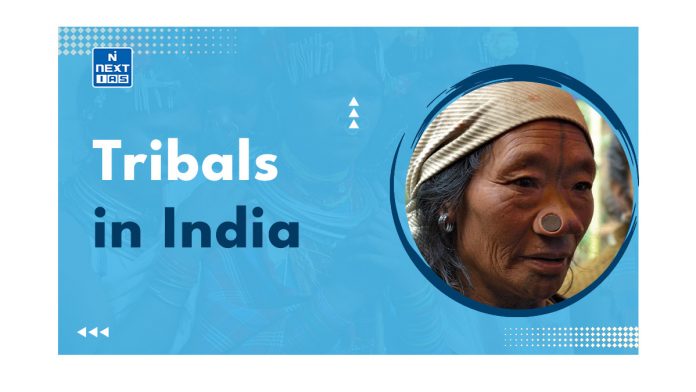Tribals in India are called Adivasi. Adivasi is a word used to describe the different tribes in India. These tribes are believed to be the original people of India before the Dravidians and Indo-Aryans. Adivasi refers to various ethnic groups considered to be the ancient inhabitants of the Indian subcontinent.
However, it’s essential to note that Tribal and Adivasi have distinct meanings. Tribal refers to a social unit, while Adivasi refers explicitly to the ancient inhabitants of the land.
Constitutional Provisions Related to Tribals in India
The Indian Constitution guarantees that no citizen shall be discriminated against. There are specific provisions in the Constitution that address the rights and welfare of Scheduled Tribes (STs):
| Service Safeguards for Tribals in India: – Article 16(4) empowers states to make provisions for reservation in appointments or posts for any backward class to ensure adequate representation. – Article 16(4A) allows states to make provisions for reservation in promotions for SC/STs if they are not adequately represented in services under the state. – Article 16(4B) clarifies that backlog vacancies will not be considered together with the vacancies of the current year for determining the ceiling of 50 percent reservation. |
| Economic Rights of Tribals in India: – Article 244(1) applies the Fifth Schedule provisions for the administration and control of Scheduled Areas and Scheduled Tribes in states other than Assam, Meghalaya, Mizoram, and Tripura, which are covered under the Sixth Schedule. – Article 275 provides Grants-in-Aid to specified states (STs & SCs) covered under the Fifth and Sixth Schedules. |
| Social Rights of Tribals in India: – Article 23 abolishes bonded labor and prohibits trafficking in human beings and forced labor. Violation of this provision is a punishable offense. – Article 24 forbids child labor, preventing children below the age of 14 from working in factories, mines, or hazardous activities. |
| Educational and Cultural Rights of Tribals in India: – Article 15(4) ensures special provisions for the educational advancement of Scheduled Tribes. – Article 46 mandates the state to promote the educational and economic interests of Scheduled Castes and Scheduled Tribes and protect them from social injustice and exploitation. – Article 350 allows the right to conserve distinct languages, scripts, or cultures. |
Issues Faced by Tribals in India
The tribals in India are facing significant challenges that are making their lives difficult.
- One major problem is the exploitation of their natural resources. The government’s policies of liberalization and globalization prioritize using resources for economic growth, which clashes with the traditional tribal view of resource utilization. This has led to the extraction of resources from tribal territories, causing ecological damage.
- Another issue is forced displacement due to large development projects. Many tribal areas have been taken over for these projects, and the displaced communities often struggle to find proper rehabilitation.
- Different tribal communities face varied problems. For instance, some suffer from poor health conditions, with shorter life expectancy and higher rates of diseases like Sickle Cell Anemia. There are also conflicts among tribes over access to natural resources and territorial control.
- The interests of market forces often take precedence over the well-being and security of the tribal people. Many tribes are left unemployed or forced to work in exploitative and low-paying jobs.
- Globalization has worsened the situation, exacerbating social exclusion and vulnerability for the downtrodden tribes. This has even led to sub-national movements seeking greater autonomy or recognition for tribal areas.
- Tribal women are particularly affected as they are often directly impacted by corporate exploitation of their lands. Poverty drives many young women from tribal areas to migrate to urban centers in search of work, where they face exploitation and poor living conditions.
- The influx of immigrant laborers and development projects have also threatened tribal cultures and habitats. Some isolated tribes, like the Sentinelese, are hostile to outsiders and need protection from interference.
Way Forward
To protect tribals in India and safeguard their rights and well-being, several measures and policies need to be implemented. Here are some key steps that can be taken:
- Social and Cultural Preservation: Take measures to preserve the unique cultural heritage of tribal communities. Encourage traditional practices and crafts, and protect their sacred sites and cultural spaces.
- Community Empowerment: Empower tribal communities by involving them in decision-making processes that concern their lives and resources. Recognize and support their traditional governance systems and cultural institutions.
- Land Rights: Ensure tribal communities have clear and undisputed ownership of their lands. Address issues of land alienation and take strict action against illegal land acquisitions.
- Awareness and Sensitization: Create awareness among government officials, law enforcement agencies, and the general public about the rights and issues of tribal communities. Sensitize them to the unique challenges faced by these communities.
- Protection of Isolated Tribes: Take necessary precautions to protect isolated tribes and their habitats. Strictly enforce the “eyes on, hands off” policy to prevent any harmful interference in their lives.
- Legal Protection: The implementation of the Forest Rights Act, which recognizes and secures the rights of tribal communities over their traditional lands, should be prioritized.
- Inclusive Development: Ensure that development projects in tribal areas are undertaken with the full consent and participation of the local communities. Projects should aim to uplift tribal livelihoods and preserve their culture, rather than causing displacement and exploitation.
- Rehabilitation and Compensation: Properly rehabilitate and compensate tribal communities affected by development projects. The government must ensure that displaced tribes receive fair compensation, adequate housing, and opportunities for a sustainable livelihood.
- Education and Healthcare: Improve access to quality education and healthcare services in tribal areas. Building schools, and healthcare centers, and improving infrastructure will help in enhancing the well-being and future prospects of tribal communities.
- Employment Opportunities: Promote skill development and employment opportunities in tribal regions. This will reduce the dependence on exploitative labor markets and provide sustainable livelihood options.
Conclusion
Tribals in India are an important part of the nation. They consist of around 8.6% of the total population. They do face a number of challenges in India. By implementing the above-mentioned measures and promoting a comprehensive approach to tribal welfare, India can work towards protecting the rights and preserving the rich cultural heritage of its tribal communities.
It is essential to foster an environment where tribal communities can thrive and enjoy the same opportunities and rights as other citizens of the country.
FAQs
What are the Articles for Tribals?
Articles related to tribals in Indian Constitution include Article 15(4), which provides special provisions for their educational advancement, Article 46, which mandates the state to promote their educational and economic interests, and Article 244(1) which applies the Fifth Schedule to Scheduled Areas and Scheduled Tribes.
What is the Articles 341 and 342?
Article 341 identifies Scheduled Castes (SCs), and Article 342 identifies Scheduled Tribes (STs). These articles list specific castes and tribes eligible for special protection and benefits under the Constitution.
What is Article 330 of the Constitution of India?
Article 330 of the Constitution reserves seats for SCs and STs in the House of the People (Lok Sabha).
Who is Called Tribals in India?
Tribals in India are indigenous communities that have distinct cultural, social, and economic characteristics. They reside in specific regions and maintain their unique traditions, customs, and languages.
What is the Tribals System of India?
The tribals in India refers to the social, cultural, and economic structure of indigenous communities. It involves tribal governance, customary practices, traditional occupations, and close-knit community bonds.









